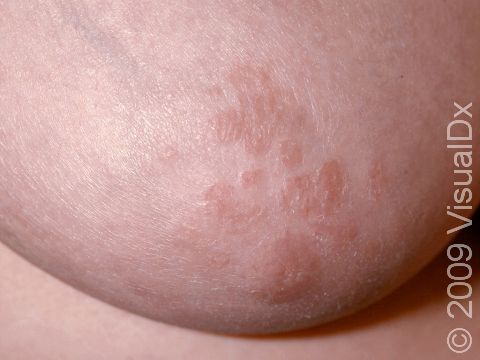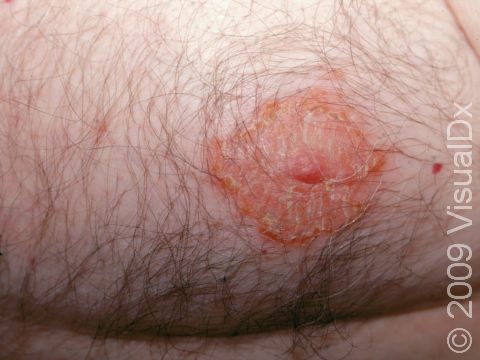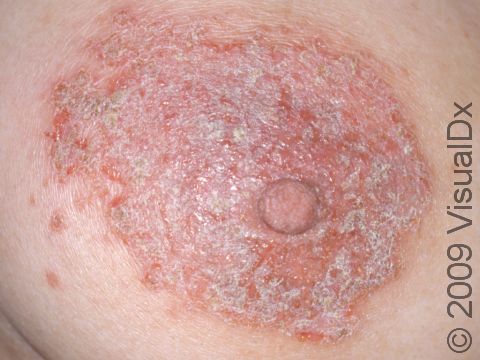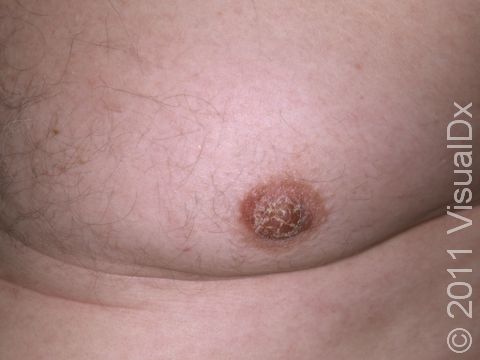Nipple Dermatitis
Nipple dermatitis describes either itchiness or soreness of either one or both nipples. There are several possible causes of this problem including:
- Eczema (atopic dermatitis)
- Thrush (oral yeast infection)
- An allergic reaction (contact dermatitis)
- Local irritation
A rare form of breast cancer, Paget’s disease, may mimic nipple dermatitis.
Who's At Risk?
Breast-feeding women often have trouble with nipple dermatitis; many have a prior history of eczema (atopic dermatitis) or easily irritated skin. Breast-feeding women with a previous history of yeast vaginitis or whose infants also use a bottle or pacifier may have more risk for a yeast nipple infection.
Allergic reactions may occur from either food particles in a nursing infant’s mouth or from lotions or creams applied to the nipple area.
Men and non-breast-feeding women who have nipple dermatitis also often have a history of eczema or easily irritated skin. Asymmetric breast size may lead to irritation from clothing or friction from exercise.
The rare breast cancer, Paget’s disease, may occur in men or women and is usually seen in older people (over 50).
Signs & Symptoms
Both the nipple itself and the darker-colored surrounding area (areola) may be red, scaling, oozing, crusted, or cracked, and itchy, painful, or tender.
Self-Care Guidelines
Non-breast-feeding individuals:
- Wash only with water, and avoid soap to the area.
- Use a mild detergent for laundry, and double rinse to remove any irritating soap residue.
- Acetaminophen or ibuprofen may be used for pain.
- Apply .5% hydrocortisone (available over the counter) twice daily to the irritated area, and protect the area from friction from clothing.
- If the area feels uncomfortable, moisten with tap water and apply petroleum jelly in a thin layer. Stop use of any other creams or lotions being used on the skin area.
Breast-feeding mothers:
- Cleanse the area after nursing with a soft warm-water-moistened cloth and then apply either a purified lanolin cream or petroleum jelly. Don’t wash this off before nursing again.
- Help from a breast-feeding counselor should be sought if there are problems with the baby positioning or latching on to the breast properly.
Common practices that are NOT recommended:
- The use of warmed tea bags on the nipples
- Drying the breast with a hairdryer
- Topical agents such as Bag Balm®
- The use of nipple shields
Treatments
- If there is no evidence of infection, a stronger topical corticosteroid cream may be advised for a few days.
- If there are signs of a yeast infection, a topical antifungal cream will be prescribed (and the baby will also be treated if breast-feeding).
- Bacterial infection will be treated with topical or oral antibiotics.
- If the doctor is suspicious of Paget’s disease, a skin biopsy may be recommended.
Visit Urgency
If there is no improvement in a few days with self-care measures, seek medical help. Seek help if there is fever or spreading redness and pain of the breast.
Breast-feeding mothers should seek help if the baby has signs of thrush, such as white patches of the mouth or tongue.
Trusted Links
References
Bolognia, Jean L., ed. Dermatology, pp.199-214. New York: Mosby, 2003.
Freedberg, Irwin M., ed. Fitzpatrick’s Dermatology in General Medicine. 6th ed, pp.274, 1180. New York: McGraw-Hill, 2003.
Last modified on October 5th, 2022 at 7:43 pm

Not sure what to look for?
Try our new Rash and Skin Condition Finder



